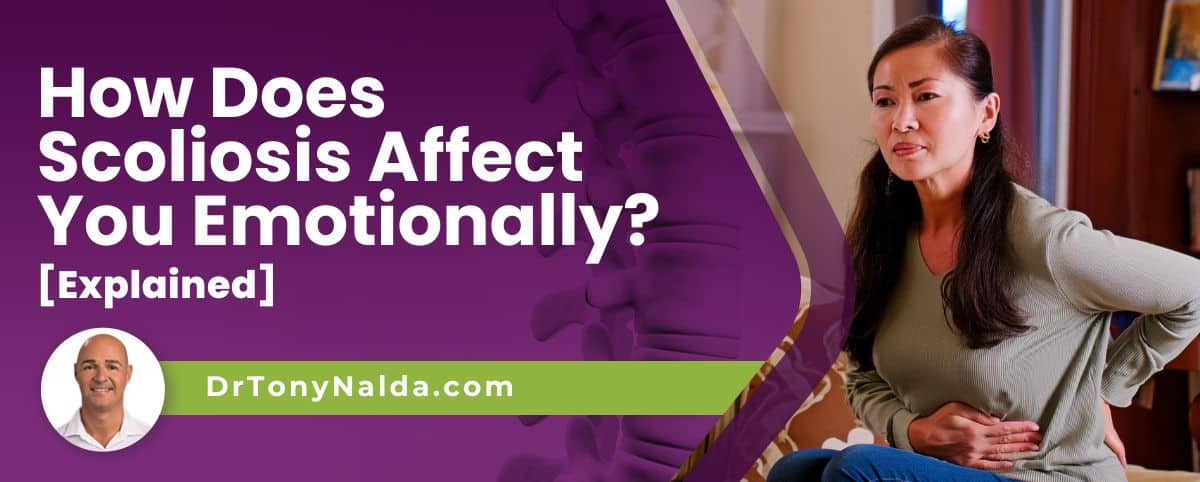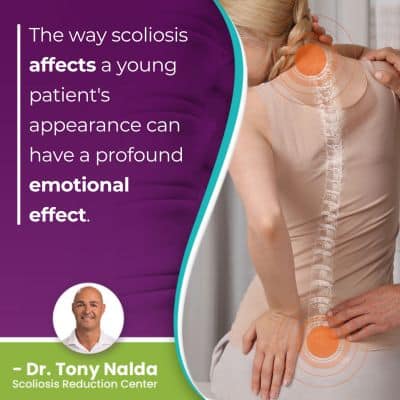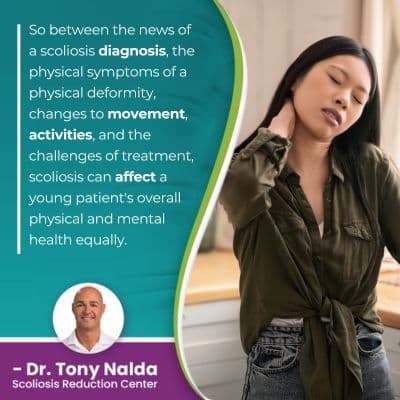How Does Scoliosis Affect You Emotionally? Explained!

Scoliosis affects people differently, particularly as the condition is diagnosed in all ages, but the most prevalent type overall is adolescent idiopathic scoliosis, diagnosed between the ages of 10 and 18. Adolescents want to fit in. They don't want to look different, walk differently, and wearing a scoliosis brace as part of treatment can impact them further.
Scoliosis is a structural spinal condition, but it doesn't just have physical effects, but also impacts patients emotionally. From being diagnosed with a life-long progressive spinal condition to the postural changes it can cause, scoliosis patients have a number of challenges.
A patient's scoliosis journey starts with a diagnosis, so let's start with how the condition is diagnosed.
Table of Contents
Hearing a Scoliosis Diagnosis
Hearing a diagnosis of scoliosis isn't easy; being diagnosed with a progressive spinal condition means it's incurable and its nature is to get worse over time.
Scoliosis can be highly treatable, particularly when with early detection, intervention, and a proactive conservative treatment approach.
So scoliosis treatment is more about how best to manage a life-long spinal condition than about reaching some type of cure.
Being diagnosed with scoliosis means an unnatural sideways curvature of the spine that also rotates has developed, and the news can be difficult to hear, particularly for adolescent scoliosis patients.
When an adolescent hears they have a progressive spinal condition, thoughts range from concerns like, "How will I wear a bathing suit this summer with my friends?" to "Is this the end of my football career?"
Hearing a scoliosis diagnosis as a teenager can feel like a sentence, but what I like to remind these young patients is that there are a number of professional athletes and celebrities that went on to fulfill their life's goals and are thriving in life, despite being diagnosed with scoliosis at at a young age.
So the news of a scoliosis diagnosis isn't good, but being aware of the condition's potential emotional effects can help minimize them.
So after adolescents have processed the news of their diagnosis, often the next major area of concern is how noticeable their conditions will be, and wanting to know how bad it can get.
Scoliosis ranges widely in severity from mild to moderate and severe to very severe, and
How Scoliosis Can Change Appearance
 The way scoliosis affects a young patient's appearance can have a profound emotional effect.
The way scoliosis affects a young patient's appearance can have a profound emotional effect.
Typically, adolescents don't want to stand apart from their peers; they want to blend in. They want to look the same and walk the same, but scoliosis can change those things.
As an unnatural sideways curvature of the spine develops and rotates, it's introducing uneven forces to the spine, its surroundings, and the entire body.
As scoliosis progresses, the size of the unnatural spinal curve is getting larger, as are the condition's uneven forces, and their effects.
Scoliosis is an asymmetrical condition, so the body's overall symmetry is disrupted, and in children and adolescents, the main effect of scoliosis involve postural changes:
- Uneven shoulders
- Uneven shoulder blades
- The development of a rib hump
- Uneven hips
- Arms and legs that appear to be different lengths
In addition, as these postural changes developed, clothing tends to become ill-fitting; necklines seem to pull to one side, and arms of shirts and legs of pants don't hang evenly.
As the body's symmetry is disrupted, changes to balance, coordination, and gait are also common, and this can make adolescents even more self-conscious as they not only look differently, but also move differently.
Negative self-image can be an issue for young scoliosis patients, and mental health is an important effect that is often overlooked as the focus is on the condition's physical effects.
Emotional support can help minimize the emotional effects of a scoliosis diagnosis, and along with the physical changes it can cause, scoliosis can also change the types of activities and sports some patients can participate in, and this is another area where quality of life can be impacted.
Activity Restrictions
When I was young, I experienced activity restrictions because of a medical condition. For me, it was chronic migraines keeping me from the sports I loved and got a lot of my sense of self from.
For adolescents with scoliosis, there are a number of factors that shape a patient's experience of life with the condition, and this is why no two cases of scoliosis are the same.
For some patients, particularly those with mild scoliosis, they don't have to give up activities they love, but for those with more-severe scoliosis and/or those that once participated in activities not deemed safe for scoliosis patients, some modifications can be necessary.
And there are some sports that are generally considered unsafe for people with scoliosis, including those that overuse one side of the body, place the spine in unnatural positions, involve hyperextension, and/or involve exposing the spine to repeated shock from impact.
So for adolescents playing tennis, horseback riding, football, and/or gymnastics, these activities will likely have to be modified, approached with caution, and/or avoided completely.
For adolescents who identify with their chosen sports and derive a sense of purpose from them, mental health issues can become an issue if they are suddenly unable to play; they can feel adrift and as if their lives don't have meaning.
Mental health problems should be approached proactively, just as treatment is; we know scoliosis has emotional effects and that young patients and young adults need emotional support, so let's provide them with it before they have to ask.
Emotional struggles/low self-esteem are evident with changes in mood, behavior, friends, and sleep.
In addition to the changes some patients experience both in their appearance and chosen activities, treatment options can also cause a psychological impact.
The Psychological Impact of Scoliosis Treatment
There are two main ways to respond with scoliosis treatment: surgically or nonsurgically.
 Surgical treatment involves fusing the spine, and this can mean a more rigid spine that has a reduced range of motion, so this type of treatment can also cause activity restrictions, and in addition, a fused spine is weaker and more vulnerable to injury: something that can have a psychological impact and cause some patients to become fearful of trying new things and become less adventurous.
Surgical treatment involves fusing the spine, and this can mean a more rigid spine that has a reduced range of motion, so this type of treatment can also cause activity restrictions, and in addition, a fused spine is weaker and more vulnerable to injury: something that can have a psychological impact and cause some patients to become fearful of trying new things and become less adventurous.
Patients treated with surgery are also often disappointed with the cosmetic results of spinal fusion as the surgery just treats the spine and not all of the condition's postural effects.
For those who choose nonsurgical treatment, this is conservative scoliosis therapy offered here at the Scoliosis Reduction Center where our results speak for themselves.
Conservative treatment integrates condition-specific chiropractic care, physical therapy, corrective bracing, and rehabilitation into customized treatment plans.
Corrective bracing is particularly effective on growing spines so is a regular facet of treatment for adolescent idiopathic scoliosis patients.
While the ScoliBrace is customized to suit a patient's body type and curvature type, it can still be difficult for an adolescent to have to wear a scoliosis brace full time, so the treatment process can also affect a patient's emotional health.
A young person's life is shaped by a number of influences, and in the modern age, the role of social media in spreading the idea of a perfect body and life can be particularly difficult for adolescents with scoliosis; their bodies aren't perfect, they're asymmetrical, they're off balance, and the changes can get worse over time if left untreated.
So between the news of a scoliosis diagnosis, the physical symptoms of a physical deformity, changes to movement, activities, and the challenges of treatment, scoliosis can affect a young patient's overall physical and mental health equally.
Conclusion
Adolescents dealing with scoliosis can also be struggling with depression, low self-esteem, negative self-image issues, and suicidal thoughts.
It can be hard for a young person to understand that a scoliosis diagnosis doesn't shape the rest of their life, and particularly with early detection and intervention, there are fewer limits to what treatment can achieve.
I like reminding young adults that just as Lamar Gant was able to become a powerlifting champion of the world with scoliosis, so too can you shape your own fate with your condition, and the type of treatment chosen is key.
Conservative scoliosis treatment is started as close to the time of diagnosis as possible, when conditions are likely to be at their mildest and most responsive to treatment; a relatively small curve can be simple to treat, but the more scoliosis progresses, the more noticeable its effects become, and the more complex it can be to treat.
While a lot of time is dedicated to physical symptoms, there are also the emotional effects of living with scoliosis that shouldn't be minimized, particularly as the condition's main type affects adolescents between the ages of 10 and 18.
Dr. Tony Nalda
DOCTOR OF CHIROPRACTIC
After receiving an undergraduate degree in psychology and his Doctorate of Chiropractic from Life University, Dr. Nalda settled in Celebration, Florida and proceeded to build one of Central Florida’s most successful chiropractic clinics.
His experience with patients suffering from scoliosis, and the confusion and frustration they faced, led him to seek a specialty in scoliosis care. In 2006 he completed his Intensive Care Certification from CLEAR Institute, a leading scoliosis educational and certification center.
About Dr. Tony Nalda
 Ready to explore scoliosis treatment? Contact Us Now
Ready to explore scoliosis treatment? Contact Us Now





